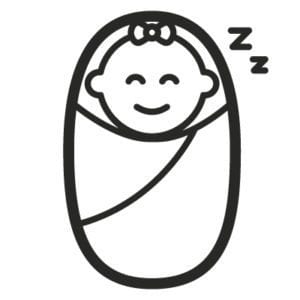I was at a girls’ weekend a few months back. My friends and I were swapping passwords so we could download each other’s electronic libraries (shhh…).
But. No one wanted my library.
That’s because the only e-books I own are baby sleep books.
(Pour one out for the fun, well-rounded person I was once.) I’ve got Jodi Mindell, Richard Ferber, Harvey Karp, Moms on Call, Marc Weissbluth, The Informed Parent, Baby 411, William Sears, Zero to Five, and Bringing up Bebe. And I’ve read them all cover-to-cover.
I did this because sleep is my spirit animal. And I was terrified of losing it when I had my daughter, Winnie. Ultimately, our winning combination was putting her to sleep drowsy but awake, with a tiny dash of sleep training at her 4-month sleep regression. But, that’s my experience. All babies are different and that’s why there are 45 million(ish) baby sleep books.
The great news is that because I’ve read all of these books, you don’t have to.*
*Note: If you’re facing a specific sleep or health issue – like night terrors or sleep apnea – it’s worth talking to your doctor and reading the books yourself.
Here’s what I’ve learned from baby sleep books:
Babies wake up… a lot. Every 45-60 minutes, in fact. All of us go through sleep cycles. Adults wake every 90 minutes or so to flip over their pillows or elbow their partners. Babies’ nervous systems are immature, so they wake every 45-60 minutes. They also tend to cry at these times. Super.
My experience: Yep. They sure do wake up a lot. No one is surprised by this.
Help baby learn to put him or herself back to sleep. Since babies wake up a lot, it’s helpful for them to learn how to go back to sleep without you. Otherwise, you get to wake up every 45-60 minutes, too. Pass.
How to Teach a Baby to Go Back to Sleep:

1. At bedtime, put baby to sleep drowsy, but awake.
Your little one feels disconcerted when she falls asleep in your arms but then wakes up an hour later in a different place. So rock, walk, sing, whatever until your sweetie is oh-so-close to asleep, but put her in her bed before her little eyes are shut tight.
My experience: I got obsessed with the definition of “drowsy.” I mean, what does “drowsy” even look like in a baby that passes out while nursing? It turns out finding the perfect amount of “drowsy” doesn’t matter at all and I was just being crazy. My best strategy was to rub W’s back a little as I put her down. Her eyelids would flutter. “Great,” I thought, “that was .05 seconds of awake, right?” Over time, W was more alert and I would put her down when her blinks started to get very heavy and slow.

2. Pause for a few seconds before going to your baby at night.
When your sweet pea inevitably wakes up in the night, take a few breaths before rushing to his or her side. Start with just one breath and build up to a longer pause over time – 2 or 3 minutes if you can. This gives your little darling a chance to go back to sleep without you.
My experience: The baby next to the bed really helped here. I could, without moving, glance over and see that W was ok without her realizing I was watching. It helped me stay calm while giving her a chance to put herself back to sleep. I imagine a bassinet or something would work the same way. Then one night, when I was doing a ~45 second pause, a miracle occurred – W put herself back to sleep before I picked her up. I cried. #hormones

3. Consider “sleep training.”
Sometimes called “cry it out,” most experts agree that this isn’t appropriate until baby is at least 4 months old. They also agree that the longer you wait after 4 months, the more difficult it is. For those that worry about damaging their children (me) by letting them cry – new research shows that babies who are sleep trained grow up to be just as secure and attached as babies who weren’t. So, sleep training doesn’t hurt your kid. That being said, it’s not for everybody and there’s no judgment here. Do what works for your family. If you want to try, read below for a common structure.
My experience: We did this at Winnie’s 4-month sleep regression. I “left to get takeout” on the first night and my husband took the first few rounds of check and console (more on that later). When I finally walked in the door 45 minutes later, the baby was asleep and hubby was drinking a beer. I still don’t know what happened during that 45 minutes, but I also don’t care.
How to Sleep Train, if it’s your thing:
The general idea is to give your little one a chance to fall asleep without your help, but not leave them to cry endlessly. There are 85 million versions, but it basically boils down to:
- Put baby down to sleep drowsy but awake.
- If baby cries, allow baby to cry for 3 minutes.
- After 3 minutes, check on baby. Pat her back, tell them you love them. *Do not* pick them up. (This is called check and console.)
- Leave the room less than minute after entering.
- Baby will wail (it is helpful to have wine, chocolate, or loud music on hand).
- Set timer for 5 minutes.
- Keep checking and consoling after increasing lengths of time until baby falls asleep.
- Repeat the following night but start with a 5 minute timer and increase from there. Keep increasing on future nights until there’s little to no crying at bedtime.
You can choose to repeat this pattern for night wakings (Ferber) or just do it at bedtime (Mindell) until your baby figures out how to put him or herself to sleep.
My experience: We just did this at bedtime, not for night wakings. I didn’t have the brainpower for the middle of the night timer. Eventually, W used her going to bed skills to also put herself back to sleep at night. I would still nurse her twice/night – but she was only waking up to eat, then went straight back to sleep. We’ve had to occasionally re-train after W’s been sick or we’ve been traveling. But that’s like 5 minutes on one night. Yay sleep!
Variations
Choose a shorter time limit: Some of us (raises hand slowly) can’t stand to hear their baby cry. So, start your check & console timers at whatever time feels best. If it’s 10 seconds, it’s 10 seconds. The next night, start at 15 seconds. Do what feels right to you. What you don’t want is for your little darling to learn to cry for exactly 1 minute and 45 seconds until you come to get her. That’s why you increase the time as the evening (and week) progresses.
Turn off the monitor: Some parents choose to turn off the monitor and close the door at bedtime. They don’t go back in the kiddo’s room until the next morning. (This the Bringing Up Bebe method, for those that are keeping score at home.) I am entirely too high strung for a no-monitor night. However, friends that have done this have nothing but good things to say. Probably not for the high-anxiety moms (who me?).
A note on Natural (or Attachment) Parenting
For natural/attachment parents, sleep training isn’t really part of the plan. Instead, parents attend to baby whenever he cries to reinforce bonding and attachment. If this is your parenting style – thanks for reading past the Ferber stuff! – you can still use the “drowsy but awake” and “pause” methods to help your baby practice sleeping, if you choose.
The good news?
Kids figure it out. Every baby is different – some babies don’t sleep well, others love to sleep oh-so-much. As far as I can tell, nobody shows up to college crying for their mommies every 45 minutes. So, whatever method you choose (or no method at all), it works out in the end.
Related: Re-Thinking the Four Month Sleep Regression




Leave a Comment